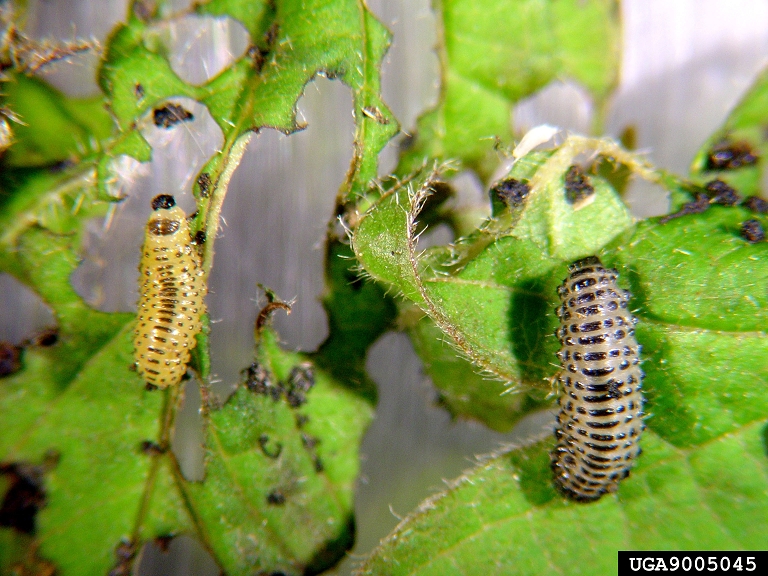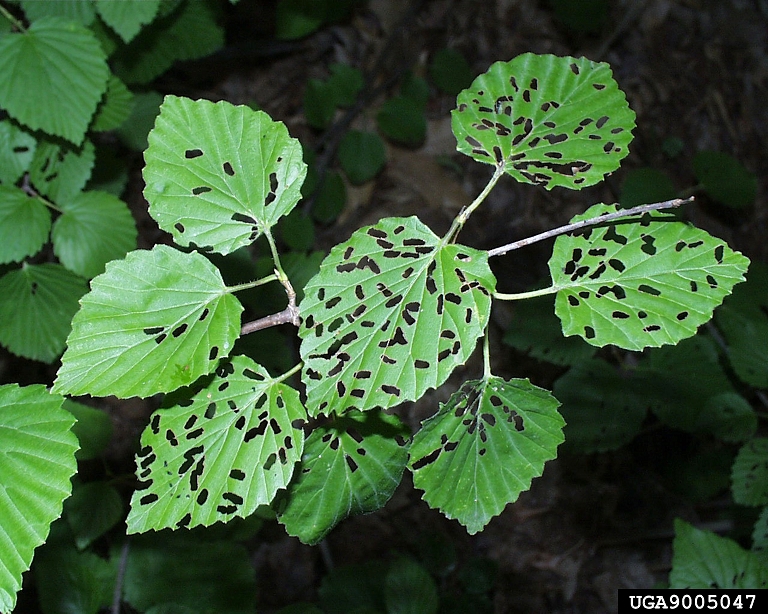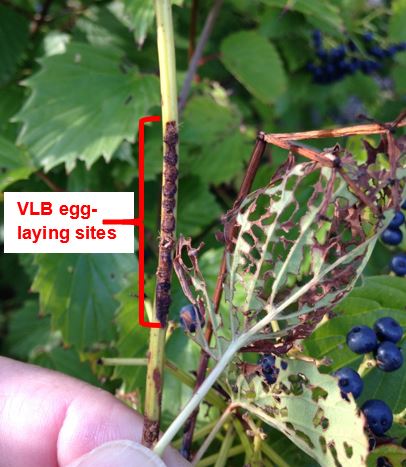What’s eating my viburnums and how can I stop it?
Viburnum leaf beetle larvae and adults may devour the shrubs in Michigan.

Since 2008, viburnum leaf beetle (VLB), Pyrrhalta viburni, has made its way across the state in search of viburnums to feed on. This invasive pest (Photo 1) is a specialist that only feeds on the leaves of shrubs in the genus Viburnum. Not all viburnums are equally appealing to VLB (Table 1).
|
Viburnum species |
Susceptible to defoliation |
|
Arrowwood (V. dentatum) |
Susceptible |
|
American cranberry bush (V. trilobum) |
Susceptible |
|
European cranberrybush (V. opulus) |
Susceptible |
|
Rafinesque viburnum (V. rafinesqueanum) |
Susceptible |
|
Sargent viburnum (V. sargenti) |
Somewhat susceptible |
|
Blackhaw viburnum (V. prunifolium) |
Somewhat susceptible |
|
Nannyberry viburnum (V. lentago) |
Somewhat susceptible |
|
Wayfaringtree viburnum (V. lantana) |
Somewhat susceptible |
|
Burkwood viburnum (V. burkwoodii) |
Less susceptible |
|
Doublefile viburnum (V. pilcatum var. tomentosum) |
Less susceptible |
|
Judd viburnum (V. juddii) |
Less susceptible |
|
Leatherleaf viburnum (V. rhytidophyllum) |
Less susceptible |

The pest life cycle
Larvae hatch from overwintering eggs in May (Photo 2). The emerging larvae are greenish-yellow and feed gregariously on the underside of tender newly expanding viburnum leaves, skeletonizing the foliage. Damage usually starts on the lower leaves with only the midribs and major veins left intact. As larvae mature, they grow to about 1/3 an inch long, darken, and develop spots on both sides of the abdomen.
Mature larvae migrate to the soil to pupate. Adults emerge from July-September and will also feed on foliage (Photo 3). VLB adult feeding damage consists of irregular circular holes. and severe feeding can nearly defoliate shrubs once again. When disturbed, the beetles will fly away or drop to the ground. Adult VLB are 1/4 to 1/3 inch long and are generally brownish.

Adults lay up to 500 eggs July through October, or until the first killing frost. They prepare laying sites by chewing small holes into a small branch or twig, usually on the current season's growth. The females lay their eggs into the hole and seal the hole with a lid or "cap" of a special cement composed of chewed bark, saliva, and excrement (Photo 4).

Economic impact
Heavy infestations of VLB can defoliate shrubs, cause dieback and eventually kill plants. Valued plantings of the European cranberrybush viburnum can be severely damaged by larval and adult feeding. Shrubs repeatedly defoliated over a period of two to three years are likely to die.
Control options
Larvae will be easier to handpick from plants compared to the mobile adults. Handpicking will only be effective if done regularly, and populations are low. During Fall, gardeners should search branches for egg-laying sites and prune these out. If your viburnums experienced severe defoliation from VLB for several seasons, consider replacing with one of the species from Table 1 that are less susceptible to beetle feeding.
Insecticidal soaps, pyrethroids (such as bifenthrin, cyfluthrin, and lambda-cyhalothrin), or chlorantraniliprole (acelepryn) can help control the VLB. These pesticides work best when applied to smaller larvae, which are typically active in late April or early May. Spinosad and chlorantraniliprole also control adult VLB if populations are large. If using spinosad, do not apply to plants in bloom as it is toxic to pollinators. Soil-applied systemic products that contain imidacloprid are also effective but should also be applied after flowering for pollinator protection. If using insecticides, be sure to read the label and follow all instructions.
Generalist natural enemies such as lacewings, predatory stink bugs, and lady beetles will feed on VLB eggs and larvae. Broad-spectrum insecticides may have a negative impact on these predators, and insecticide should be avoided if you spot beneficial insects controlling VLB.
This work is supported by the Crop Protection and Pest Management Program [grant no 2024-70006-43569] from the USDA National Institute of Food and Agriculture. Any opinions, findings, conclusions, or recommendations expressed in this publication are those of the author(s) and do not necessarily reflect the view of the U.S. Department of Agriculture.



 Print
Print Email
Email

